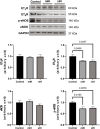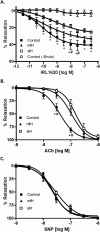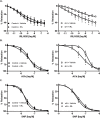Gestational intermittent hypoxia induces endothelial dysfunction and hypertension in pregnant rats: role of endothelin type B receptor†
- PMID: 37823770
- PMCID: PMC11484499
- DOI: 10.1093/biolre/ioad139
Gestational intermittent hypoxia induces endothelial dysfunction and hypertension in pregnant rats: role of endothelin type B receptor†
Abstract
Obstructive sleep apnea is a recognized risk factor for gestational hypertension, yet the exact mechanism behind this association remains unclear. Here, we tested the hypothesis that intermittent hypoxia, a hallmark of obstructive sleep apnea, induces gestational hypertension through perturbed endothelin-1 signaling. Pregnant Sprague-Dawley rats were subjected to normoxia (control), mild intermittent hypoxia (10.5% O2), or severe intermittent hypoxia (6.5% O2) from gestational days 10-21. Blood pressure was monitored. Plasma was collected and mesenteric arteries were isolated for myograph and protein analyses. The mild and severe intermittent hypoxia groups demonstrated elevated blood pressure, reduced plasma nitrate/nitrite, and unchanged endothelin-1 levels compared to the control group. Western blot analysis revealed decreased expression of endothelin type B receptor and phosphorylated endothelial nitric oxide synthase, while the levels of endothelin type A receptor and total endothelial nitric oxide synthase remained unchanged following intermittent hypoxia exposure. The contractile responses to potassium chloride, phenylephrine, and endothelin-1 were unaffected in endothelium-denuded arteries from mild and severe intermittent hypoxia rats. However, mild and severe intermittent hypoxia rats exhibited impaired endothelium-dependent vasorelaxation responses to endothelin type B receptor agonist IRL-1620 and acetylcholine compared to controls. Endothelium denudation abolished IRL-1620-induced vasorelaxation, supporting the involvement of endothelium in endothelin type B receptor-mediated relaxation. Treatment with IRL-1620 during intermittent hypoxia exposure significantly attenuated intermittent hypoxia-induced hypertension in pregnant rats. This was associated with elevated circulating nitrate/nitrite levels, enhanced endothelin type B receptor expression, increased endothelial nitric oxide synthase activation, and improved vasodilation responses. Our data suggested that intermittent hypoxia exposure during gestation increases blood pressure in pregnant rats by suppressing endothelin type B receptor-mediated signaling, providing a molecular mechanism linking intermittent hypoxia and gestational hypertension.
Keywords: blood pressure; eNOS; endothelin type B receptor; endothelium; intermittent hypoxia; pregnancy.
© The Author(s) 2023. Published by Oxford University Press on behalf of Society for the Study of Reproduction. All rights reserved. For permissions, please e-mail: journals.permissions@oup.com.
Conflict of interest statement
The authors have declared that no conflict of interest exists.
Figures







References
-
- Gupta R, Rawat VS. Sleep and sleep disorders in pregnancy. Handb Clin Neurol 2020; 172:169–186. - PubMed
-
- Spence DL, Allen RC, Lutgendorf MA, Gary VR, Richard JD, Gonzalez SC. Association of obstructive sleep apnea with adverse pregnancy-related outcomes in military hospitals. Eur J Obstet Gynecol Reprod Biol 2017; 210:166–172. - PubMed
-
- Redline S, Tishler PV, Hans MG, Tosteson TD, Strohl KP, Spry K. Racial differences in sleep-disordered breathing in African-Americans and Caucasians. Am J Respir Crit Care Med 1997; 155:186–192. - PubMed
-
- Hutcheon JA, Lisonkova S, Joseph KS. Epidemiology of pre-eclampsia and the other hypertensive disorders of pregnancy. Best Pract Res Clin Obstet Gynaecol 2011; 25:391–403. - PubMed
Publication types
MeSH terms
Substances
Grants and funding
LinkOut - more resources
Full Text Sources
Medical

